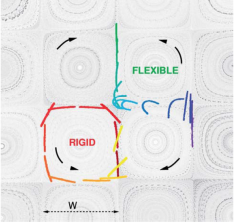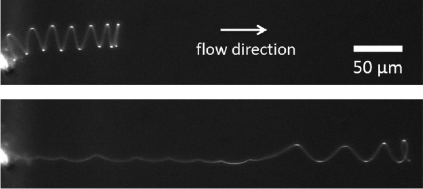[\
 At the PMMH we study fluid-structure interactions at low Reynolds number, describing how flexible objects are deformed and transported by a viscous flow. Numerical and theoretical studies have driven this active field over the last decade, but experimental approaches are still scarce, mainly due to the lack of well controlled experimental model systems. To overcome these limitations, we have during the last years designed an experimental platform combining perfect control of flow geometries and particle properties (shape, dimension and mechanical properties) taking advantage of recent developments in microfabrication and microfluidic techniques. Particle conformation and trajectories can be monitored using fluorescent labeling techniques and a 3D tracking algorithm. Our platform now allows us to study a large range of particles (see image) in different flow geometries.
At the PMMH we study fluid-structure interactions at low Reynolds number, describing how flexible objects are deformed and transported by a viscous flow. Numerical and theoretical studies have driven this active field over the last decade, but experimental approaches are still scarce, mainly due to the lack of well controlled experimental model systems. To overcome these limitations, we have during the last years designed an experimental platform combining perfect control of flow geometries and particle properties (shape, dimension and mechanical properties) taking advantage of recent developments in microfabrication and microfluidic techniques. Particle conformation and trajectories can be monitored using fluorescent labeling techniques and a 3D tracking algorithm. Our platform now allows us to study a large range of particles (see image) in different flow geometries.
Coupling between deformation and transport

The complex coupling between deformation and transport is well illustrated by the transport dynamics of a flexible fiber in a counter rotating flow. Above a certain threshold, given by the elasto-viscous number, fiber buckling takes place and changes the transport dynamics (see image). Simulations using slender body theory capture well the experimental dynamics.
Helical ribbons
Flexible, microscale helical ribbons with nanoscale thickness are stretched when submitted to viscous flow in a microfluidic channel. Understanding these general helical behaviors can lead to insights on natural helices, such as flagella, as well as the development of synthetic helices, such as swimming microbots. Well-characterized helices can also be used to measure local stresses in flows of simple or complex fluids.

Confined channels
When microfibers are transported in confined channels, complex dynamics arise from their transport anisotropy, coupled with wall interactions, and fiber oscillations are observed (see figure). More complex shapes or flexible fibers lead to even more complex dynamics./]



